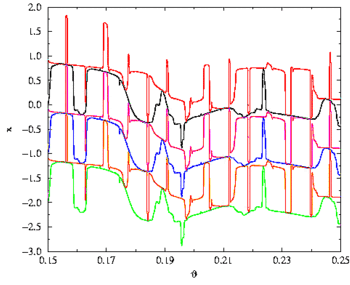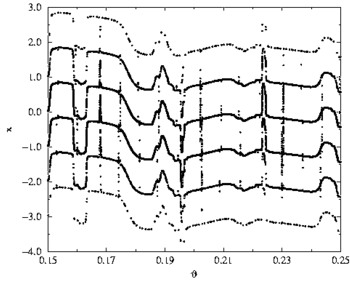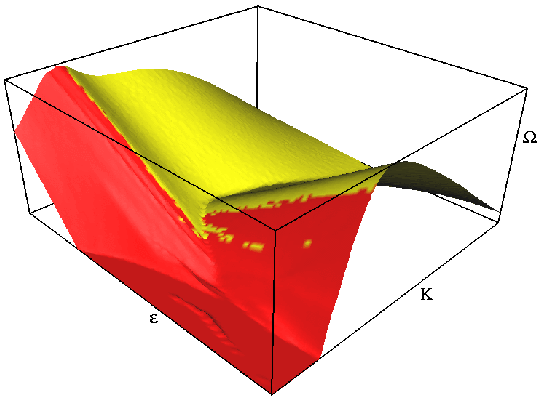 Next: A nonsmooth codimension-2 bifurcation
point
Next: A nonsmooth codimension-2 bifurcation
point
 Next: A nonsmooth codimension-2 bifurcation
point
Next: A nonsmooth codimension-2 bifurcation
point
In the two-sided nonsmooth saddle-node bifurcation the attractor collides both with the repellor immediately above and below it. This leads to bidirectional diffusive motion as shown in Figure 10.


Figure 10:
Two-sided nonsmooth saddle-node bifurcation with  = 0 and
= 0 and  = 2.58 (cf. the transition from the
white to the blue region in Figure 11: (left)
before the collision (K = 0.927): attractors in black, blue
and green, repellors in red, purple and orange; (right) after the
collision (K = 0.928): SNA with the same initial condition as
the black attracting invariant curve (left). The strange repellor is
not shown.
= 2.58 (cf. the transition from the
white to the blue region in Figure 11: (left)
before the collision (K = 0.927): attractors in black, blue
and green, repellors in red, purple and orange; (right) after the
collision (K = 0.928): SNA with the same initial condition as
the black attracting invariant curve (left). The strange repellor is
not shown.
We find the nonsmooth saddle-node bifurcations on the boundary of the phase-locked region. The two-sided nonsmooth saddle-node bifurcation is the transition from the white region to the blue region in Figure 11 (left).
Both one-sided and two-sided nonsmooth saddle-node bifurcations take
place in the red region in ( ,
K,
,
K,  )-space; see Figure 1 and the enlargement of the third
region of overlap in Figure 12. The one-sided
bifurcation happens when the tongue boundary has non-negligable
height.
)-space; see Figure 1 and the enlargement of the third
region of overlap in Figure 12. The one-sided
bifurcation happens when the tongue boundary has non-negligable
height.

Figure 12:
A small part of the boundary of the phase-locked region with zero
rotation number;  in [2.52,
2.62] runs from right to left, K in [0, 1] also from right to
left, and
in [2.52,
2.62] runs from right to left, K in [0, 1] also from right to
left, and  in [0, 0.004] from
bottom to top; compare Figure 11 (left). A grid
of 80 X 160 points in the (
in [0, 0.004] from
bottom to top; compare Figure 11 (left). A grid
of 80 X 160 points in the ( , K)-plane is taken. Red regions correspond to
transitions to SNAs (the yellow spots are due to the finithe
threshold).
, K)-plane is taken. Red regions correspond to
transitions to SNAs (the yellow spots are due to the finithe
threshold).
 Next: A nonsmooth codimension-2 bifurcation
point
Next: A nonsmooth codimension-2 bifurcation
point
Created by Hinke Osinga
Last modified: Wed May 17 16:11:04 2000